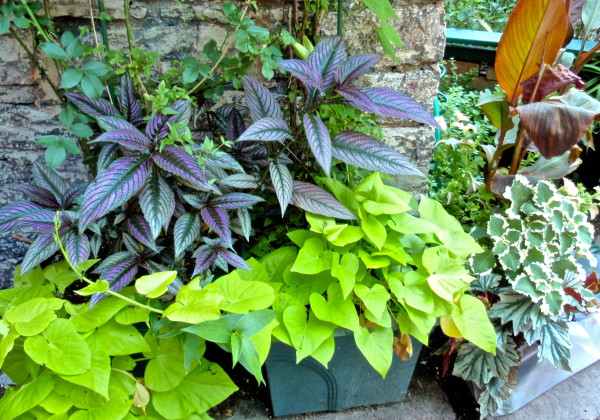

What do I see as I drive around town these days? Green. Not green-with-envy-green, but rather the everyone’s-garden-is-green, too, green. It’s a beautiful sight.
Recent rains have enriched our gardens and encouraged plants to bloom and to leaf out, drawing my eye to all the contrasting new foliage making a statement in the garden.
Most gardeners are drawn to blooms when planning their landscapes – bright, tubular blooms that attract hummingbirds, butterflies and bees, the proper formality of traditional roses, or the wispy ephemeral blooms of plants like Mexican bird of paradise or desert willow.
Neglected and left sitting on the sidelines, foliage is too often an afterthought in gardening, pushed aside by the drive for endless flowers.
But foliage – with its myriad contributions that enhance, brighten, and add movement and structure to the landscape – should play a starring role in designing a garden. It is the fundamental element that brings the design together.
When blooms fade in winter or in the death throes of a scorching summer, foliage maintains the unity in the garden – creating harmony in the landscape. And seasonal foliage color can transform a fall and winter garden when traditionally green leaves turn brilliant hues of gold and red.
Foliage adds its own color year-round as well. Endless hues of green – forest green, grass green, blue green, gray green, lime green, partner with black, purple and silvery leaves to make vibrant pallets.
Variegated and color-splattered leaves like Aztec grass, coleus and caladiums put on their own show.
From the brilliant burgundy of loropetalum or purple heart to golden Japanese maples to the delicate lime green of many ferns – the contrast of foliage in the garden adds interest and sophistication to the landscape. In shady beds, light colors and variegated foliage brighten dark areas with a pop of light.
Foliage with different or unusual textures also provides dimension to the garden. Beds with rows of shrubs with roughly the same leaf color, size and texture is one-dimensional and uninteresting. It all looks the same. Imagine such an area with contrasting foliage, some with glossy green leaves, some with fuzzy, sage-colored leaves and some variegated grasses. Each element allows the other to shine through and stand out. Add a special plant with very structural foliage and you now have a focal point.
The smooth, structural simplicity of a franzosini agaves provides a contrasting backdrop that enhances the display of the plant in front of it.
The shapes and textures of plant foliage also provide the blueprint for crafting a variety of garden styles.
Pairing a broad range of plant textures creates contrast. Coarse textures with large irregular leaves, thick veins, rough bark, medium textures with mid-size leaves, smoother shape and simple lines, and fine textures with small or thin, strappy leaves like grasses, wispy and lacy foliage can all make striking combinations.
To emulate a tropical garden style, for example, choose foliage with large, glossy leaves, contrasting lime, yellow and burgundy colors and very course, textured plants. Examples would include palms, gingers, cannas, sagos, esperanzas, and potato vine — plants we can grow here in Central Texas.
Conversely, a cottage garden typically includes smaller, more delicate leaves and wispy forms of foliage like lacy lavender, flowing Artemesia, delicate columbine and the fine tufts of dianthus.
Foliage also adds rhythm to the garden. Soft grasses and billowing foliage create the illusion of movement. They draw the eye into the landscape to see what lies beyond their beckoning leaves.
Plants with strong structural foliage beg to be focal points in the garden – providing interest, a place for the eye to rest, and definition in landscape. Agaves, acanthus and aralia all bring dynamic form to design.
I’m as fond of blooms as any gardener, but the next time you head to your local independent nursery, take stock of your shrubs, foundation plants and flowers and go find yourself some fabulous foliage to bring new life to your garden.
A Landscape Designer and Garden Coach, Diana Kirby provides landscaping tips at http:/www.dianasdesignsaustin.com and writes a garden blog at https://www.dianasdesignsaustin.com

